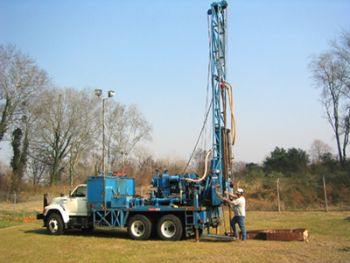Rotary Drilling: Difference between revisions
Rmanwaring (talk | contribs) (Created page with "<!-- Delete any sections that are not necessary to your topic. Add pictures/sections as needed --> __NOTOC__ ---- {{Picture <!-- Add image file name (ex.image.jpg) --> |image= USACE_Savannah_District_-_Geotechnical_&_HTRW_Capabilities_(8476083021).jpg <!--Add link if applicable --> |link= <!-- Add picture caption --> |caption= Drill Rig }} <!-- Introductory paragraph or topic page summary --> "Types of rotary drilling include: *direct rotary drilling; *rev...") |
Rmanwaring (talk | contribs) No edit summary |
||
| Line 24: | Line 24: | ||
==[[Best Practices Resources]]== | ==[[Best Practices Resources]]== | ||
{{Document Icon}} [[National Engineering Handbook: Chapter 5 - Engineering Geology Logging, Sampling, and Testing]] | {{Document Icon}} [[National Engineering Handbook: Chapter 5 - Engineering Geology Logging, Sampling, and Testing]] | ||
<!-- In the location of an in text citation, simply enclose the citation as follows: <ref> citation </ref>. Citations will automatically populate. Learn more at https://www.mediawiki.org/wiki/Help:Cite. --> | <!-- In the location of an in text citation, simply enclose the citation as follows: <ref> citation </ref>. Citations will automatically populate. Learn more at https://www.mediawiki.org/wiki/Help:Cite. --> | ||
Revision as of 15:53, 25 October 2022

|
| Drill Rig |
"Types of rotary drilling include:
- direct rotary drilling;
- reverse circulation rotary drilling;
- dual-wall reverse circulation drilling;
- core drilling."[1]
A rotary drill advances a test hole by rapid mechanical rotation of the drilling bit (e.g., blade, tricone, and coring bits), which is made of carbide, tungsten, case-hardened steel, and diamonds. The bit cuts, chips, and grinds the material at the bottom of the hole into small particles. The cuttings are normally removed by pumping water or drilling fluid from a sump down through the drill rods and bit and up through the annular spacing into a settling pit and back to the sump. Compressed air is also available on many rigs as an alternative to remove the cuttings from the hole. Air rotary drilling is essential for drilling in karst areas where circulation loss is expected.
Rotary-drilling methods can advance test holes in a wide variety of materials, including hard rock. Rotary drilling may be the only practical method of advancing holes and obtaining undisturbed core samples from certain types of soil and rock materials.
Best Practices Resources
![]() National Engineering Handbook: Chapter 5 - Engineering Geology Logging, Sampling, and Testing
National Engineering Handbook: Chapter 5 - Engineering Geology Logging, Sampling, and Testing
Citations:
Revision ID: 4043
Revision Date: 10/25/2022
